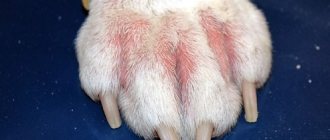Allergic reactions occur in dogs no less often than in humans. The only difference is that a pet facing this problem cannot talk about it on its own. Only the owner can recognize the disease at an early stage and prevent its complications. To do this, he needs to know what the main symptoms that indicate an allergy in an animal look like.
Common Causes of Allergic Reactions
The characteristic signs of allergies in dogs arise from allergens: the body recognizes these substances as foreign and activates its defenses to destroy them. Allergens include:
- medicines;
- chemicals and cosmetics;
- Food;
- worms, viruses, fungi and bacteria;
- fabrics;
- saliva of blood-sucking insects;
- pollen and grass;
- house dust and even your own cells.
The causes of allergies in dogs lie not only in external, but also in internal factors.
The disease is inherited, depends on stress and is typical for a number of breeds:
- spaniels;
- French bulldogs;
- Dalmatians;
- Shar Pei;
- Great Danes;
- German Shepherds;
- golden retrievers;
- Labradors;
- dachshund;
- dogs with white color.
Owners of animals at risk are advised to more carefully follow preventive measures. This will help reduce the number and severity of allergic attacks.
Prevention
Prevention from the development of allergies in animals includes the following measures:
- Constantly ventilate the room where the dog is.
- indoor cleaning without the use of chemicals.
- banning smoking, ensuring access to drinking water.
- walks with your pet during flowering in open areas, away from plants, washing paws after walks.
- Periodic washing with flea shampoo.
- nutrition control.
- selection of high-quality hypoallergenic food.
- introducing new products in small portions (for food allergies).
- periodic introduction of immunomodulatory drugs into the diet.
If your dog is allergic to certain foods, you should stock up on antihistamines. Taking them in a timely manner will make your pet’s life easier and reduce the risk of developing various negative consequences.
Particular attention should be paid to the nutrition of puppies, because... they do not have strong immunity, and for normal development they require a sufficient supply of vitamins, micro- and macroelements and other useful substances. Therefore, the diet should be balanced and nutritious.
Stages and features of the course
Activating the body's defenses to fight infections and helminth infections is understandable and justified. These factors can really cause harm. A similar reaction to harmless plants or products is a failure of the immune system, explained by increased sensitivity, this is an allergy.
The immune response to a stimulus goes through 3 stages. The speed at which the first signs of allergy appear in dogs depends on the amount of allergen that has penetrated.
Immune response
After contact with the pathogen, the immune system begins to produce antibodies - protein compounds that fight foreign “invaders”. At the same time, the level of lymphocytes and eosinophils increases.
Pathochemical process
When neutralizing foreign substances, particles from decay accumulate on healthy cells, damaging the structure. This increases the amount of free histamine lying dormant in mast cells. Once free, histamine begins to transmit nerve impulses to the brain center.
Pathophysiological disorders
The body, having received a signal of danger, launches responses. They lead to disorders of the skin and respiratory system. The patient experiences muscle spasms, increased salivation, swelling, rashes with itching and inflammation. To relieve symptoms, medications are used that suppress the production of histamine - that is, antihistamines.
How allergies manifest themselves and progress in dogs
The speed at which symptoms appear varies from person to person. In some animals, the first signs appear immediately after contact, in others only after a few weeks. Contact with allergens results in:
- constant itching;
- dry skin leading to seborrhea;
- frequent diarrhea;
- the formation of rashes, swelling and scratching;
- increased production of tear fluid and nasal mucus;
- hair loss, fraught with the appearance of bald spots;
- increased sweating, not typical for the canine family;
- redness and peeling on the pads of the paws and between the toes;
- inflammation of the ears, accompanied by viscous and purulent discharge.
The thick fur of some pets makes it difficult to detect symptoms in a timely manner. It is impossible to notice violations of the skin without a thorough check.
What to do if an allergy to a dog is confirmed?
The answer to this question depends on the decision of the person who has been diagnosed with an allergy to dogs. If the animal does not live with you, then it is necessary to minimize contact with other people’s dogs; If the meeting cannot be avoided, you can take antihistamines in advance and wear a medical mask. If an allergy is discovered in a dog owner, he will have to decide whether he will part with the pet forever. A positive solution to this issue implies that the source of the allergy will be eliminated.
When meeting a dog, use a medical mask
But there are also owners who are not ready to betray their four-legged companion and want to reconcile their illness with the presence of a dog in the house. In this case, enhanced preventive measures are needed.
First of all, you need to limit the animal’s movement around the apartment by selecting an area where the dog is not allowed to enter (best of all, if it is a room where a person sleeps). The animal should not be allowed onto the sleeping area or upholstered furniture; you should not allow the dog to lick you; too much tactile contact is undesirable. When walking with your dog, you can wear gloves to prevent saliva from getting on your skin when the animal brings a stick or toy.
Clean regularly
The living area needs to be cleaned regularly and thoroughly: vacuuming, dusting, it is advisable to install humidifiers or even air washers that remove the smallest allergens from it. It is worth getting rid of heavy curtains and drapes, removing carpets, removing covers or bedspreads with folds from furniture. Bed linen should be washed once a week, carefully ironing. Each room should be ventilated before going to bed, and the windows should be left open so that fresh air always enters the room.
Maintain your pet's hygiene
The last, most important rule concerns hygiene and care for the animal itself. The dog must be healthy, have vaccinations and be treated for parasites. The fact is that a pet’s reduced immunity makes it more allergenic. If an allergy sufferer lives with the animal, the dog should be washed more often, using a gentle hypoallergenic dog shampoo. A person who does not suffer from an allergic reaction should be instructed to regularly comb the animal, freeing it from dead fur. Of course, the procedure should not be carried out indoors; you can do it on a walk or take your pet to the groomer. If the breed allows, a long-haired dog can be cut shorter.
Remember that there are no hypoallergenic dog breeds, as some puppy breeders claim. We mentioned above that allergies to animal fur rarely occur; the true causative agent of the reaction is a protein that is found on the skin of the animal, in urine and feces, saliva, and grease from the fur.
Relief of allergic attacks
The next step is to take standard pharmaceutical medications that eliminate allergy symptoms. Let us remind you that this disease has no cure; a person can only stop the attack. To do this, you can use a combination of tablets and nasal sprays; if prescribed by a doctor, injections can be used. Let's look at the most popular and effective antihistamines.
Table 2. Remedies for allergic attack relief
| Name | Action | approximate cost |
| Zodak, tablets | Effective against seasonal and persistent allergies, relieve nasal congestion, eliminate redness of the eyes, runny nose, and itching. One tablet per day is enough | 300 rubles for 30 pieces |
| "Suprastin", tablets or solution for injection | Not only does it have a targeted effect against allergy symptoms, but it also has a sedative effect. An injection of this drug helps in emergency situations, for example, the development of edema | 150 rubles for 20 pieces or 140 rubles for 5 ampoules |
| CromoHexal, nasal spray | Inhibits the release of histamine in the body, which provokes allergies. Used as a means of cumulative action, useless as a quick aid | 170 rubles for 15 milliliters |
| "Erius", tablets | Blocks histamine receptors, has an antipruritic effect, relieves swelling of tissues and spasms of mucous membranes. Does not cause sedation | 600 rubles for 10 pieces |
| "Fenistil", drops | A product with antiallergic and antipruritic effects. The effect is achieved a few minutes after application. Slight drowsiness may occur after administration | 400 rubles for 20 milliliters |
| Allegra tablets | An antihistamine that does not affect the nervous system. Effective for skin itching, urticaria, and other allergic rashes | 550 rubles for 10 pieces |
| "Vibrocil", nasal drops | Effectively relieves congestion in the respiratory tract, relieves mucosal swelling and itching, restores normal breathing | 350 rubles for 15 milliliters |
In any case, the treatment regimen should be selected by a specialist, an allergist, having in hand the results of examinations and allergy tests. Of course, it is not forbidden to have antihistamines in your medicine cabinet, knowing about your predisposition to allergies, but you cannot prescribe medications to take on an ongoing basis without a doctor.
There is a method of treating allergies based on the regular introduction of antigens into the body - specific hyposensitization. The patient is injected with the allergen subcutaneously or orally, in microscopic doses and for a long time. It has been proven that the effectiveness and success of this method reaches 90%. By and large, the hyposensitization technique is also used by dog owners who do not give up their pet and spend some time with it every day.
Let us note that there are often cases when an allergy to dogs goes away over time in people who do not refuse to communicate with their pet. The fact is that the human immune system may no longer consider the allergen foreign, and the reaction stops.
Video - Allergy to dogs: typical misconceptions
Types of reactions
The type of reaction depends not only on the speed of onset of symptoms, but also on the type of stimulus. According to this classification, it can be edible and non-edible, where the latter is further divided into several subspecies.
Food
A negative reaction to food is due to intolerance to animal or plant proteins. Most often they are contained in:
- red fruit and vegetable products;
- soybeans used in the production of meat products;
- cereals;
- fish and fish oil;
- artificial additives included in economy-class feed;
- chicken meat flavored with antibiotics;
- lactose contained in any dairy products;
- egg whites.
In addition to the classic symptoms, the patient sometimes experiences vomiting, an unusual odor from the mouth, and inflammation of the mucous membranes and tongue. The condition normalizes when the allergen product is eliminated.
Seasonal (for pollen)
Pollen that enters the respiratory tract is absorbed into the blood and stimulates the production of histamine. Allergic attacks occur only during flowering seasons. Most often they fall in spring and summer. Based on the method of penetration, the disease is called respiratory.
Contact
Occurs through direct or indirect contact with an irritant. With this type of allergy, peeling, nettle rash and redness form on the skin of dogs. The paw pads and interdigital spaces are primarily affected. The cause of the disease is synthetic and woolen fabrics, chemical fumes, hygiene products and pesticides sprayed on the street.
For bites
Flea allergies in dogs are often diagnosed. It is caused not by the parasites themselves, but by foreign proteins contained in the anesthetic saliva. When bitten, the flea injects it to temporarily reduce the sensitivity of the “host” and get enough blood.
This species is easily distinguished by the presence of parasites. An infected dog develops severe itching. His skin turns red and peels. A rash appears in the groin and sacrum.
Atopic
Chronic skin allergies in dogs that are genetically determined are called atopic dermatitis. It cannot be treated and is caused by all of the listed allergens. Animals at risk suffer from atopic dermatitis. Most often it occurs before 3 years of age.
The disease affects targeted areas: armpits, groin area, ears and muzzle. The affected areas become bald, discolored, very itchy and inflamed. At the site of inflammation, blisters with pus form.
Infectious
Infectious allergies in dogs occur as a consequence, and its treatment involves taking antibiotics. In this case, all allergic symptoms are secondary – signs of an infectious disease come first. Animals with this diagnosis are often re-infected.
Autoimmune
All autoimmune disorders are associated with malfunctions of the immune system. The body begins to produce antibodies to its own cells. Symptoms of the pathology vary from person to person and may include:
- papular formations on the mucous membranes and skin (pemphigus, Senir-Usher syndrome);
- changes in skin color (vitiligo);
- damage to connective tissue and blood vessels (lupus erythematosus);
- atopic dermatitis (cutaneous vasculitis, bullous pemphigoid);
- inflammation of the vascular walls (vasculitis);
- cartilage damage (polychondritis);
- target-shaped rash (erythema multiforme).
The disease is inherited, so it is better not to allow an animal with autoimmune disorders to be bred.
Diagnosis and identification of allergen
After detecting symptoms, all that remains is to make an accurate diagnosis and understand what the dog may be allergic to. Treatment before diagnosis is inappropriate and can harm the animal.
Elimination method
To determine the allergen, an elimination diet is prescribed. Her scheme consists of replacing the usual diet with the completely opposite one and gradually introducing familiar foods.
When dry feeding, the pet is switched to dietary food with a different composition, and when feeding it natural, all previous products are excluded. They are added again a few weeks after the symptoms disappear. Monitoring reactions to introduced foods helps identify and permanently eliminate allergenic foods from the diet.
If the allergy is non-food, then the owners need to track when the animal has a reaction: after cleaning (to chemicals), when a bouquet of flowers appears in the house, etc.
Laboratory tests
Before treatment, it is necessary to eliminate other possible pathologies. To do this, the veterinarian:
- examines skin scrapings;
- evaluates nutrition and identifies possible allergenic foods;
- analyzes stool and blood samples;
- performs trichoscopy;
- examines a four-legged patient for the presence of fleas and other blood-sucking insects.
Additionally, allergy tests are performed. During skin tests, tiny incisions are made in the patient's top layer of skin. The veterinarian drops typical irritants into them and monitors the level of the body's reaction.
Preparing the animal for cortisol analysis
In order for an endocrinological study to obtain reliable results, the owner must know how to prepare his four-legged friend for manipulation. First of all, you need to make sure that the test is carried out in the morning. A prerequisite, according to veterinary experts, is adherence to a fasting diet. As a rule, the pet is prescribed an 8-hour fast.
Due to the fact that the test result is greatly influenced by the use of a number of medications, the owner should be warned that the dog is receiving medications. The study data can be distorted by the used estrogens, progestins, and Prednisolone. False-positive results can be produced by anticonvulsants, as well as long-term use of glucocorticoids.
When performing the dexamethasone test, it is important that the animal is not stressed, as the hormones produced can distort the results.
Treatment and care
All types of allergies in dogs and their treatment involve eliminating allergens and existing symptoms. Patients are prescribed medications and prescribed a hypoallergenic diet.
First aid for anaphylactic shock
If allergic symptoms are detected, veterinarians recommend refraining from self-treatment. An exception is allowed only in the case of anaphylactic shock (anaphylaxis), a deadly, rapid reaction. It is caused either by drug injections and insect bites, or by ingestion and sudden inhalation of large quantities of the irritant. Depending on the cause, the condition is accompanied by:
- acute pain at the injection/bite site or in the abdomen;
- redness and swelling of the affected area;
- vomiting and diarrhea;
- itching, covering not only the contact site, but also other areas;
- swelling in the throat;
- lowering blood pressure.
No more than an hour is allotted to save a pet. The victim is administered intravenously or intratracheally (through the trachea) adrenaline and epinephrine. Not all owners are able to do this on their own, so it is safer to contact a veterinary or dental clinic. Anesthetics used in dental treatment often cause allergic reactions, so dentists always have all the necessary medications in case of anaphylaxis.
Prescribed medications
In addition to eliminating the irritant and relieving symptoms, treatment involves caring for the affected skin and taking immunomodulators. The choice of drugs directly depends on the form of the disease:
- Food
. Proteins are excluded from the diet until symptoms disappear completely. Over time, prohibited products are returned, and the allergens found are eliminated.
- Seasonal
. Antihistamines are used regularly during the flowering period.
- Contact
. To eliminate itching, swelling and other signs of the disease, antihistamines are prescribed.
- Insect
. First of all, the animal is rid of parasites. After their destruction, the condition returns to normal.
- Atopic and autoimmune
. Instead of antihistamines, glucocorticosteroids are used and suppress the immune system.
- Infectious
. Once the underlying cause of the disease is identified, the virus or other infectious agent is destroyed with antibiotics.
Most options involve taking antihistamines. The most popular include Suprastin, Ketotifen, Claritin, Diphenhydramine and Promethazine.
Nutrition and special feed
For 2 months, the animal is put on a therapeutic diet that excludes major allergens. When dry feeding, hypoallergenic super-premium or holistic-class food is used. In the second case, the diet is not changed, but in the first, it is gradually changed to the original, simultaneously eliminating the identified allergens.
First aid
If acute signs of allergies begin to appear, it is necessary to immediately take measures to eliminate them. In some cases, the disease can lead to unpleasant consequences, even death (with a strong reaction).
In this case, the following activities are carried out:
- The pet needs to be given an antihistamine (give a tablet or an injection).
- Place the dog in a comfortable position so that nothing interferes with normal breathing.
- provide free access to fresh air.
- If the animal vomits, it is necessary to clear the oral cavity of food debris.
- If your pet goes into anaphylactic shock, you should immediately administer the hormonal drug dexamethasone.
It is important to remember that timely help will avoid unpleasant problems with your dog’s health. Especially in cases where the allergy is particularly pronounced.











